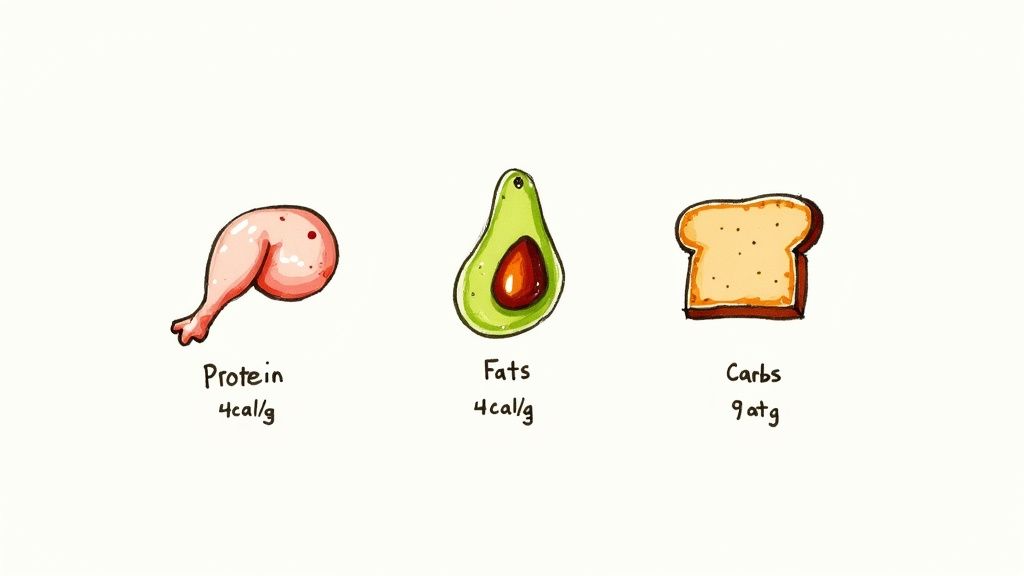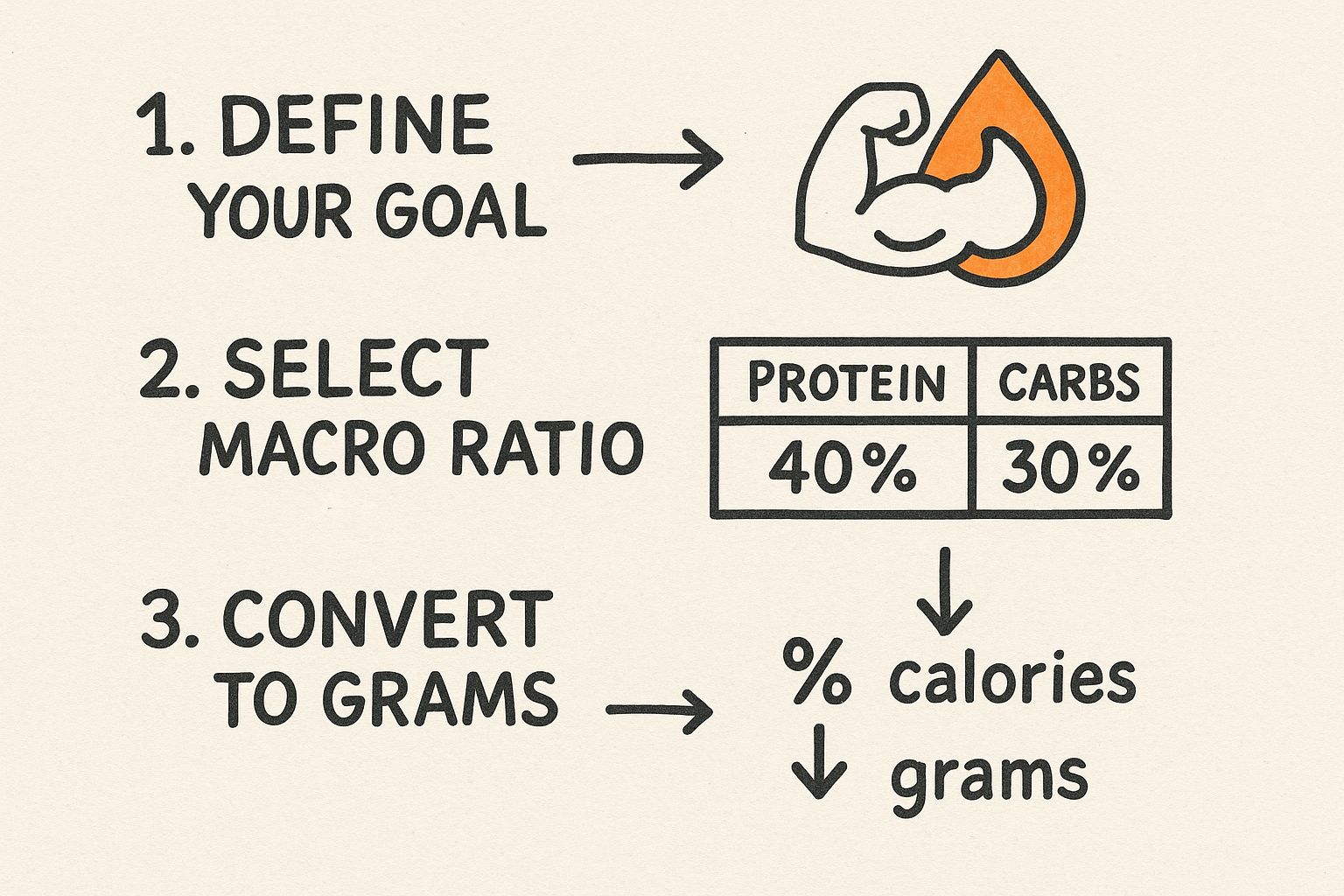Learn how to calculate macronutrients for your fitness goals. This guide breaks down calorie needs, macro ratios, and tracking with real-world examples.
This article is proposed by Gymkee, the personal trainer software that allows you to deliver the best coaching experience to your clients while saving time and growing your personal training business.
Try Gymkee for free for 14 daysCalculating your macronutrients is a straightforward process. First, determine your daily calorie needs. Second, divide those calories among protein, carbohydrates, and fats based on your fitness goals.
This method gives you a clear, actionable nutrition plan. You'll move beyond simply counting calories to understanding which sources of energy your body needs to perform optimally.

Before setting macro targets, you must establish your total energy budget. This is your Total Daily Energy Expenditure (TDEE), which represents the total calories your body burns in 24 hours.
This number is the foundation of your plan. Every macro target is a percentage of your TDEE. Think of TDEE as your total budget; you can't allocate funds (macros) until you know how much money (calories) you have.
The starting point is your Basal Metabolic Rate (BMR). This is the energy your body requires to perform basic life-sustaining functions like breathing, blood circulation, and organ function, assuming you're at complete rest.
The Mifflin-St Jeor equation is a widely used and reliable formula for estimating BMR.
This calculation provides your baseline calorie needs. The next step is to adjust this figure for your daily activity level.
To determine your TDEE, multiply your BMR by an activity multiplier that reflects your typical daily movement. Be honest in your self-assessment for an accurate calorie target.
Use this table to find the multiplier that best matches your daily activity level to calculate your Total Daily Energy Expenditure (TDEE).
The final calculation is BMR x Activity Multiplier = TDEE.
Key Takeaway: Your TDEE is an estimate combining your body's baseline needs with your physical activity. Accurate self-assessment of your activity level is critical.
The Mifflin-St Jeor equation is a strong starting point. Other predictive formulas like the Harris-Benedict or Katch-McArdle equations also estimate metabolic rate. As the experts at NASM explain in their guide to counting macros, these tools are all designed to provide a reliable baseline, which you then fine-tune based on real-world results.

With your daily calorie target set, the next step is to allocate that energy budget among the three macronutrients: protein, carbohydrates, and fats. Each plays a distinct physiological role. Viewing them as interchangeable calories is a common mistake that leads to suboptimal results.
Protein is essential for muscle repair and growth, particularly after training. It also serves as the building block for hormones, enzymes, and immune cells.
For weight management, protein is the most satiating macronutrient. A higher protein intake promotes fullness, which can make adhering to a calorie deficit more manageable.
Carbohydrates are the body’s preferred source of energy for high-intensity exercise and brain function. Inadequate carbohydrate intake can lead to fatigue, reduced cognitive function, and poor workout performance.
Dietary fats are critical for health. They are necessary for the production of hormones like testosterone, the absorption of fat-soluble vitamins (A, D, E, and K), and maintaining the structural integrity of cells. Avoiding fat negatively impacts these functions.
Prioritize healthy fat sources, such as:
The Core Math: Each macronutrient has a specific energy value, which is the foundation for converting your calorie target into a gram-based plan. Protein and carbohydrates provide 4 calories per gram, while fat provides 9 calories per gram. These values are the standard used in nutrition science.

There is no single "best" macro split. The optimal ratio depends directly on your primary objective, whether it's fat loss, muscle gain, or maintenance. A fat loss plan prioritizes protein to preserve muscle, while a muscle gain plan requires more carbohydrates to fuel training.
The following table provides evidence-based starting points for macro splits based on common fitness goals. These are guidelines that should be adjusted based on individual response.
These percentages are starting points. The key is to monitor your progress and adjust as needed.
For fat loss, protein intake is crucial. A higher protein intake, typically 30-40% of total calories, helps preserve lean body mass during a calorie deficit. Protein also has the highest thermic effect of food (TEF), meaning your body expends more energy digesting it compared to carbs and fats.
For deeper insights, explore various cutting phase strategies.
A common starting point for fat loss is:
This distribution is designed to maximize satiety and muscle retention while providing adequate energy.
Building muscle requires sufficient protein for raw materials and ample carbohydrates to fuel intense workouts that stimulate hypertrophy. Inadequate carb intake will compromise training performance and limit muscle growth potential.
A standard macro ratio for muscle gain is:
This split prioritizes carbohydrates for performance and glycogen replenishment while ensuring adequate protein for muscle protein synthesis. Integrating this nutrition strategy is a key component of effective personal training programming.
A Practical Example: For a 2,000-calorie target, a muscle gain split (30/40/30) translates to 150g protein, 200g carbs, and ~67g fat. The fat loss split (40/30/30) shifts this to 200g protein, 150g carbs, and ~67g fat.
For maintaining your current physique, a balanced approach is most effective. The extreme macro splits of a cutting or bulking phase are unnecessary.
A sustainable maintenance split is:
This ratio provides sufficient protein for muscle repair, carbohydrates for energy, and fats for hormonal health, creating a sustainable, long-term eating strategy.
Let's apply these steps to a practical example.
Meet Alex. He is 30 years old, 5'10" (178 cm), and weighs 185 lbs (84 kg). He works a desk job and strength trains 3-4 times per week. His goal is fat loss without sacrificing muscle mass or energy.
We'll determine his TDEE, starting with his BMR using the Mifflin-St Jeor formula.
Next, we account for his activity level. Training 3-4 times a week qualifies as moderately active, so we use a 1.55 multiplier.
To promote fat loss, we'll apply a moderate calorie deficit. A 15-20% reduction is sustainable. We'll use 20%.
The Starting Point: Alex's daily calorie target for fat loss is 2,240 calories. This number is the basis for his macronutrient targets.
Using the fat loss ratio of 40% protein, 30% carbohydrate, and 30% fat, we can calculate Alex's macro targets based on his 2,240-calorie goal.
Calculate calories per macro:
Convert calories to grams:
Alex's daily target for fat loss is 224g of protein, 168g of carbs, and 75g of fat, for a total of approximately 2,240 calories. He can now use these figures to build his meals.

Calculating macros is the plan; tracking is the execution. Without tracking, your calculations are merely theoretical. The objective is not robotic perfection but consistent adherence over time. Focus on weekly averages rather than hitting exact numbers daily.
To track accurately, you need two tools. Guesstimating portion sizes is a primary source of error.
Alternatively, an integrated platform like Gymkee’s nutrition builder allows coaches to set macro goals and build meal plans for clients in one place, streamlining the process.
Daily perfection is unrealistic. The key is to build sustainable habits that accommodate real-life scenarios. For those with demanding schedules, services like the best high-protein meal delivery services can help ensure protein targets are met consistently.
Focus on Weekly Averages, Not Daily Perfection: If you exceed your carb target one day, compensate by returning to your plan the next. An isolated off-day has a negligible impact on long-term progress; a week of inconsistent tracking does not.
Here are direct answers to common questions about calculating and tracking macros.
No. Striving for perfection often leads to frustration and non-adherence. Progress is driven by long-term consistency. Aim to be within ±5-10 grams of your protein and fat targets, as these are critical for physiological function. Let carbohydrates fill the remainder of your daily calorie budget. A "good enough" week is more effective than a "perfect" day followed by quitting.
Your macronutrient needs change as your body changes. Re-evaluate your targets when:
Online calculators provide a solid initial estimate by using the standard formulas discussed in this guide. However, the most accurate "calculator" is your body's response. Use an online tool to get your starting numbers, then track your progress (weekly weigh-ins, gym performance, energy levels) and adjust based on that real-world data.
Yes. The principles of energy balance and macronutrient functions are the same regardless of dietary preference. The primary challenge for a vegan diet is achieving adequate protein intake without excessive carbohydrates or fats. This requires careful planning and reliance on high-protein plant sources like tofu, tempeh, lentils, and quality vegan protein supplements.
Ready to stop guessing and start coaching with precision? Gymkee provides all the tools you need to create, track, and adjust nutrition plans seamlessly for your clients. Design custom meal plans, set macro goals, and monitor progress all in one platform. Start your free 14-day trial today.
This article is proposed by Gymkee, the personal trainer software that allows you to deliver the best coaching experience to your clients while saving time and growing your personal training business.
Try Gymkee free for 14 days